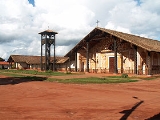
Concepción, Santa Cruz
Encyclopedia
This article is about the Bolivian town. For other towns/cities named Concepción, see Concepción (disambiguation).
Concepción is a town in the lowlands of Eastern Bolivia
. It is known as part of the Jesuit Missions of the Chiquitos
, declared in 1990 a World Heritage Site
, as a former Jesuit Reduction.
in the Santa Cruz Department
and is located at an elevation of 500 m above sea level, circa 250 kilometers northeast of Santa Cruz de la Sierra
, the department's capital.
Between 1753 and 1756 the cathedral of Concepción was built (see photo), which still is the center of the blooming town. In 1766, Concepción was inhabited by 713 families and 3,276 persons. When in 1767 Charles III
expelled the Jesuits
and the village was administered by secular authorities, many of its inhabitants fled to the woods.
During the decade that followed the population decreased drastically, caused by epidemics, famine, the mismanagement of the new clergy and - at the end of the 19th century - by deporting the indigenous
population to the rubber
plantations.
Also the Lonely Planet's Bolivia guide, 6th Edition / April 2007, uses weather data from Concepción in a climate chart (page 368).
Concepción is a town in the lowlands of Eastern Bolivia
Bolivia
Bolivia officially known as Plurinational State of Bolivia , is a landlocked country in central South America. It is the poorest country in South America...
. It is known as part of the Jesuit Missions of the Chiquitos
Jesuit Missions of the Chiquitos
The Jesuit Missions of the Chiquitos are in the Santa Cruz department of eastern Bolivia. Six of the missions have been designated a UNESCO World Heritage Site. The missions are distinguished by the fusion of European and American Indian cultural influences...
, declared in 1990 a World Heritage Site
World Heritage Site
A UNESCO World Heritage Site is a place that is listed by the UNESCO as of special cultural or physical significance...
, as a former Jesuit Reduction.
Location
Concepción is the capital of Ñuflo de Chávez ProvinceÑuflo de Chávez Province
Ñuflo de Chávez is one of the fifteen provinces of the Bolivian Santa Cruz Department and is situated in the northern central parts of the department. The name of the province honors the conquistador Ñuflo de Chaves who founded the city of Santa Cruz de la Sierra. Its capital is Concepción...
in the Santa Cruz Department
Santa Cruz Department
Santa Cruz, with an area of 370,621 km², is the largest of the nine constituent departments of Bolivia. In the 2001 census, it reported a population of 2,029,471. The capital is the city of Santa Cruz de la Sierra. The state is one of the wealthiest states in Bolivia with huge reserves of...
and is located at an elevation of 500 m above sea level, circa 250 kilometers northeast of Santa Cruz de la Sierra
Santa Cruz de la Sierra
Santa Cruz de la Sierra, commonly known as Santa Cruz, is the capital of the Santa Cruz department in eastern Bolivia and the largest city in the country...
, the department's capital.
History
Concepción was founded in 1699 by Jesuits and served as a mission place for the Christianization of the Guaraní people. In 1722 the village moved to its present place, and in 1745 it was inhabited by circa 2,000 people of the Punasicas, Boococas, Tubasicas, Paicones, Puyzocas, Quimonecas, Quitemos, Napecas, Paunacas and Tapacuracas tribes.Between 1753 and 1756 the cathedral of Concepción was built (see photo), which still is the center of the blooming town. In 1766, Concepción was inhabited by 713 families and 3,276 persons. When in 1767 Charles III
Charles III of Spain
Charles III was the King of Spain and the Spanish Indies from 1759 to 1788. He was the eldest son of Philip V of Spain and his second wife, the Princess Elisabeth Farnese...
expelled the Jesuits
Society of Jesus
The Society of Jesus is a Catholic male religious order that follows the teachings of the Catholic Church. The members are called Jesuits, and are also known colloquially as "God's Army" and as "The Company," these being references to founder Ignatius of Loyola's military background and a...
and the village was administered by secular authorities, many of its inhabitants fled to the woods.
During the decade that followed the population decreased drastically, caused by epidemics, famine, the mismanagement of the new clergy and - at the end of the 19th century - by deporting the indigenous
Indigenous peoples of the Americas
The indigenous peoples of the Americas are the pre-Columbian inhabitants of North and South America, their descendants and other ethnic groups who are identified with those peoples. Indigenous peoples are known in Canada as Aboriginal peoples, and in the United States as Native Americans...
population to the rubber
Rubber
Natural rubber, also called India rubber or caoutchouc, is an elastomer that was originally derived from latex, a milky colloid produced by some plants. The plants would be ‘tapped’, that is, an incision made into the bark of the tree and the sticky, milk colored latex sap collected and refined...
plantations.
Population
The town's population has increased strongly in the past decades:- 1969: 1,100 inhabitants
- 1992: 3,228 inhabitants (census)
- 2001: 5,586 inhabitants (census)
- 2008: 8,221 inhabitants (est.)
Climate
The climate in the Concepción area is typical of the Bolivian lowlands east of the Andes, and weather data from Concepción is used to illustrate the weather and climate of the region. The table at shows the average weather conditions at Concepción. (Note that BBC mis-spell Concepción with a t: Conceptión).Also the Lonely Planet's Bolivia guide, 6th Edition / April 2007, uses weather data from Concepción in a climate chart (page 368).
Famous inhabitants
- Hugo Banzer Suárez (1926–2002), Bolivian president 1971-1978 and 1997–2002

